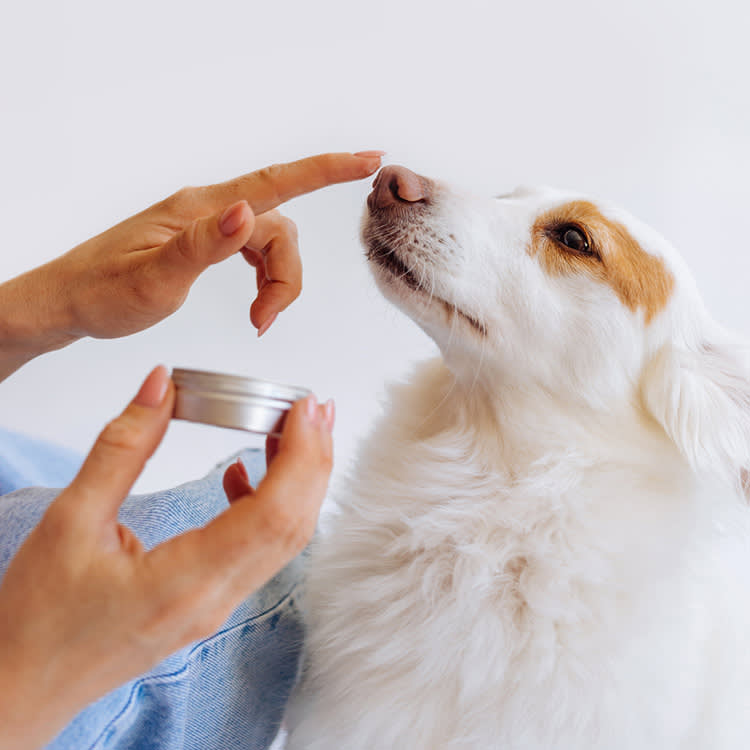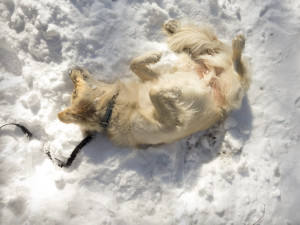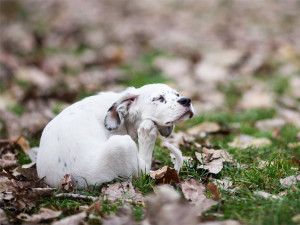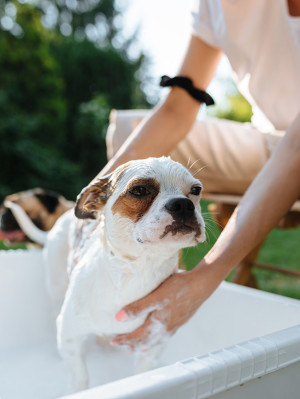Home Remedies for Hot Spots
Your dog’s most annoying problem of the week—solved.

share article

Your pet wants you to read our newsletter. (Then give them a treat.)
If your dog has ever suffered from a hot spot, you know how miserable they can be and how scary they can look at first. Hot spots come in many varieties, with some being more superficial and mild, while others can be deep and severe. Home remedies for hot spots opens in a new tabare best for those cases when you catch the hot spot early, and it’s still mild.
Treatments include: keeping the area clean and dry, using soothing products to ease the itch, and employing techniques to prevent them from licking at the area. If their hot spot is severe or does not improve with home remedies, see a veterinarian.
When treating a hot spot, there are a few underlying principles to keep in mind. First, treatments should be aimed at drying out the skin and reducing moisture around the hot spot. Second, work to improve your dog’s overall discomfort, which may include reducing pain, itchiness, and/or underlying conditions that initiated the irritation. Third, take steps to stop them from licking and chewing at the area. Finally, if their symptoms cannot be controlled with at-home remedies, be sure to see your vet right away to ensure there is not another cause for their skin problem and/or a need for prescription medical treatments.
What are hot spots?
Hot spots on dogsopens in a new tab can vary in their appearance and underlying causes. The main components of this condition include an initial irritation or painful condition that leads your pup to start licking or chewing at their skin. This self-trauma creates a focal area of hair loss with red, moist, irritated skin that may be raw, oozing, and/or scabbed over. These wounds are often painful, and they may shy away from having them touched. Once the skin has been damaged in this way, it’s very susceptible to secondary infection, so that’s why many hot spots are also infected.
Treatments are aimed at cleaning and drying the skin, preventing your dog from licking and causing any further damage, and controlling discomfort including pain, itch, and any underlying conditions that led them to start licking in the first place. Some underlying skin problems that can lead to a hot spot include allergiesopens in a new tab, fleasopens in a new tab, and/or infections, so be sure to speak with your vet about treating these problems at the same time. Hot spots are also more common in warm, humid weather and in certain breeds of dogs with thick coats.
While some treatments can be initiated at home, it’s very important to consult your vet if your dog seems to be in a lot of pain, has signs of an infection such as pus or discharge surrounding the wound, or any other changes in their health or behavior. Often, prescription medications are necessary to cure hot spots that are infected and/or more severe.
What are the home remedies for hot spots?
There are many reported home remedies for dog hot spots that are not necessarily safe and effective treatments, so it’s important to check with your vet before attempting to treat at home. There are also other medical conditions that may resemble a hot spot but require very different treatments so if you are not sure what’s up with your pup, be sure to have your vet do a thorough physical exam and make a diagnosis before using any at-home treatments. That said, hot spots that are caught early may respond well to basic home treatment and it’s worth a try if you can get it under control quickly and effectively.
Here are some treatments and their pros and cons:
Clean and dry the area
This is usually the first step in treating a hotspot. Since these areas tend to be very moist from a dog’s overzealous lickingopens in a new tab, anything you can do to keep the area clean and dry will help it to heal. Ideally, the fur should be clipped away with an electric razor to remove matted and moist fur and allow the skin to be exposed. Then, the skin should be gently cleaned using cool water.
Cool compresses
Applying a cool compress to the skin, such as with a moistened towel, can be soothing and help to reduce swelling, inflammation, and itchiness. This can also help to keep the surface of the skin clean and free of debris. Ideally, try to apply the cool compress for 10 minutes at a time, every eight to 12 hours.
Topical hydrocortisone cream
This is not a recommended home remedy for hot spots. While steroids, like hydrocortisone, are sometimes used in the treatments of hot spots, they are not always appropriate and should only be used if recommended by a veterinarian.
Additionally, cream-based products can keep the skin too moist and a goal of hot spot treatments is to allow these wounds to dry out as much as possible. If a steroid is indicated, your vet will likely prescribe it in another form instead of a cream. Also, be sure your dog does not ingest any topical steroid products; these can cause unwanted side effects.
Aloe vera gel
This extract from the aloe vera plant can be soothing to the skin, and some studies suggest it may have antimicrobial and wound-healing properties, though this is still under investigation. There is a lot of variation between products, based on how the gel is extracted from the plant, and depending on what preservatives are present.
It can cause local irritation of the skin in some dogs and may also cause diarrhea if ingested by your pup. Be sure to try this on an area of healthy skin first to see if your dog can tolerate it, and always prevent your dog from licking or ingesting any of the gel. Avoid using this product on broken or bleeding skin.
Calendula cream
Calendula is an extract from the flower of the pot marigold. It has been used in traditional medicineopens in a new tab for the treatment of minor wounds and mild skin irritation for centuries. It may provide some benefits in soothing the skin and would best be used at the earliest stage of irritation, before there is too much moisture or any broken skin associated with the irritation. It is very important for hot spots to dry out so using a cream-based product is not recommended once the area has become moist.
There may be other formulations containing calendula that are more helpful at that stage. Always check the ingredient list to ensure there is nothing that could be toxic to dogs in the product, and avoid any alcohol-based products; these will sting if applied to open, raw skin.
Chamomile tea
Many teas contain tannic acids, which are believed to help soothe itchy skin. Chamomile in particularopens in a new tab has been used traditionally for its perceived anti-microbial benefits, as well as anti-inflammatory and antioxidant effects.
It may work best to apply cooled tea bags directly to the affected area, or you can use a concentrated brewed tea that has been cooled and then dabbed onto the skin. Always double-check that the tea is cool before using, and don’t apply this to any open wounds.
Epsom salt bath
Epsom salts are made of magnesium sulfate and act to reduce swelling by drawing moisture out. This is best used on areas of the skin with mild swelling that can be easily soaked like the feet and are not typically used to treat hot spots. Epsom soaks can keep the skin too moist, so they should not be used on skin that is already very moist.
Antibacterial ointment
There are many different products available that contain antibacterialopens in a new tab and/or antimicrobial ingredients. Some may contain antibiotics like neomycin, polymyxin, or bacitracin. Others may contain antimicrobial ingredients, such as hypochlorous acid. These can be helpful in treating secondary infections at the site of the hot spot.
It is best to use a product that is not ointment-based, however, because the petroleum-based ointments will keep the skin moist and may delay wound healing. Many of these products may be toxic if ingested by your dog, so it’s very important to prevent them from licking at the area if these products have been applied to the skin. Cases that are more severe may require oral antibiotics so if you are concerned that your dog’s hot spot is infected, be sure to consult your vet right away.
Cone, aka Elizabethan collar
It may not be nearly as cool as some of the other treatments here, but the cone of shame serves a critical role in allowing your dog’s hot spot to heal. It’s imperative that they stop licking at the area in order for the skin to dry out and heal. You can get a little more creative than the basic plastic cone nowadays, and there are many styles available that will prevent your dog from licking. Just make sure the fit is correct and that they truly can’t sneak around it to lick
Tips for using home remedies safely
As you can see, there are many steps you can take at home to help soothe your dog’s hot spot and get them on track to healing. It’s important to keep a close eye on the skin and be sure to see your vet if you notice signs that the hot spot is getting worse. Signs, such as your dog looking like they are in pain, a bad odor, discharge from the skin, worsening redness or other changes in the color of the skin, and/or any signs of systemic illness like lethargy, not eating, vomitingopens in a new tab, diarrheaopens in a new tab, or difficulty breathing, are all reasons to see your vet right away.
Additionally, if the skin is not improving after a few days of home treatments, be sure to see your vet; some hot spots will require more advanced treatment and/or prescription medications. In general some good tips to keep in mind with these home treatments include:
Always test any new home remedy on a small area of your dog's healthy skin before using it over a larger area or an area that is abnormal. Watch for any signs of irritation and discontinue right away if they occur.
Avoid using home remedies on broken skin or open wounds.
Avoid alcohol-based products; these will cause pain and stinging if applied to irritated skin.
Refrain from using petroleum-based ointments and creams that may keep the area too moist and slow down healing.
Be sure to address your dog’s underlying reasons for being itchyopens in a new tab or in pain; these will motivate them to lick and chew, and may lead to recurrence of the hot spot if they are not treated. This includes consistently applying flea and tick preventatives year-round and treating skin allergiesopens in a new tab or other skin conditions as recommended by your veterinarian.
If your dog’s hot spot does not improve or worsens after a few days of using a home remedy, see a vet.
FAQs (People also ask):
Are hot spots contagious to other dogs or animals?
Hot spots are not contagious. Some of the underlying conditions that cause your dog to be itchy and lead to a hot spot are contagious, however. This includes fleas and other contagious skin conditions.
When should I see a veterinarian for hot spots?
If you are unsure if your dog’s condition is a hot spot, see a vet first to get an accurate diagnosis. If you are attempting to treat a hot spot at home, and it gets worse after a few days, or you notice signs that it is more serious such as discharge from the skin, a bad odor, and/or a reaction from your dog, see a vet right away.
References:

Dr. Amy Fox, DVM
Amy Fox, DVM is a small animal veterinarian in New York City. A lifelong animal lover, Dr. Fox studied biology in college and then worked as a veterinary nurse before pursuing veterinary school at Cornell University. She has worked in many different settings including shelter medicine, emergency medicine, general practice, and animal cruelty and forensics. She is especially interested in nutrition, preventative medicine and care for senior pets. Dr. Fox also enjoys writing about veterinary medicine and teaching. In her free time she loves to cook, garden, and go for long runs.
Related articles
![Brown terrier dog scratching its ear outdoors]() opens in a new tab
opens in a new tabRelief for Your Dog: Discover Effective Solutions for Their Seasonal Allergies
A vet explains why environmental allergies flare up and what to do about it.
![Little dog getting showered by his owner in the backyard.]() opens in a new tab
opens in a new tabHow to Treat Dog Skin Diseases at Home
And how you might safely give your pup immediate relief.
![Black puppy itches behind her ear due to flea allergy]() opens in a new tab
opens in a new tabShoo, Flea: What to Do About Your Dog’s Disturbing Flea Allergy
Before you say “ewww” Moira Rose-style, learn these steps to prevent and remove fleas.
![A dog scratching itself among the leaves outside.]() opens in a new tab
opens in a new tabImmunotherapy Can Be the Solve For Your Dog’s Allergies
If allergens were to ask, “Am I the drama?,” the answer would be yes.
![a Chihuahua dog licking their paw]() opens in a new tab
opens in a new tabWhy Is Your Dog Obsessed With Licking Their Paws?
Their toes might smell like Fritos, but there’s no way they taste that good.
![Mixed-breed puppy licks its paw in the grass]() opens in a new tab
opens in a new tabHot Spots on Dogs: Causes, Symptoms, and Treatment
Unfortunately, this term refers to a “summer sore,” not a club coveted by SNL’s Stefon.









